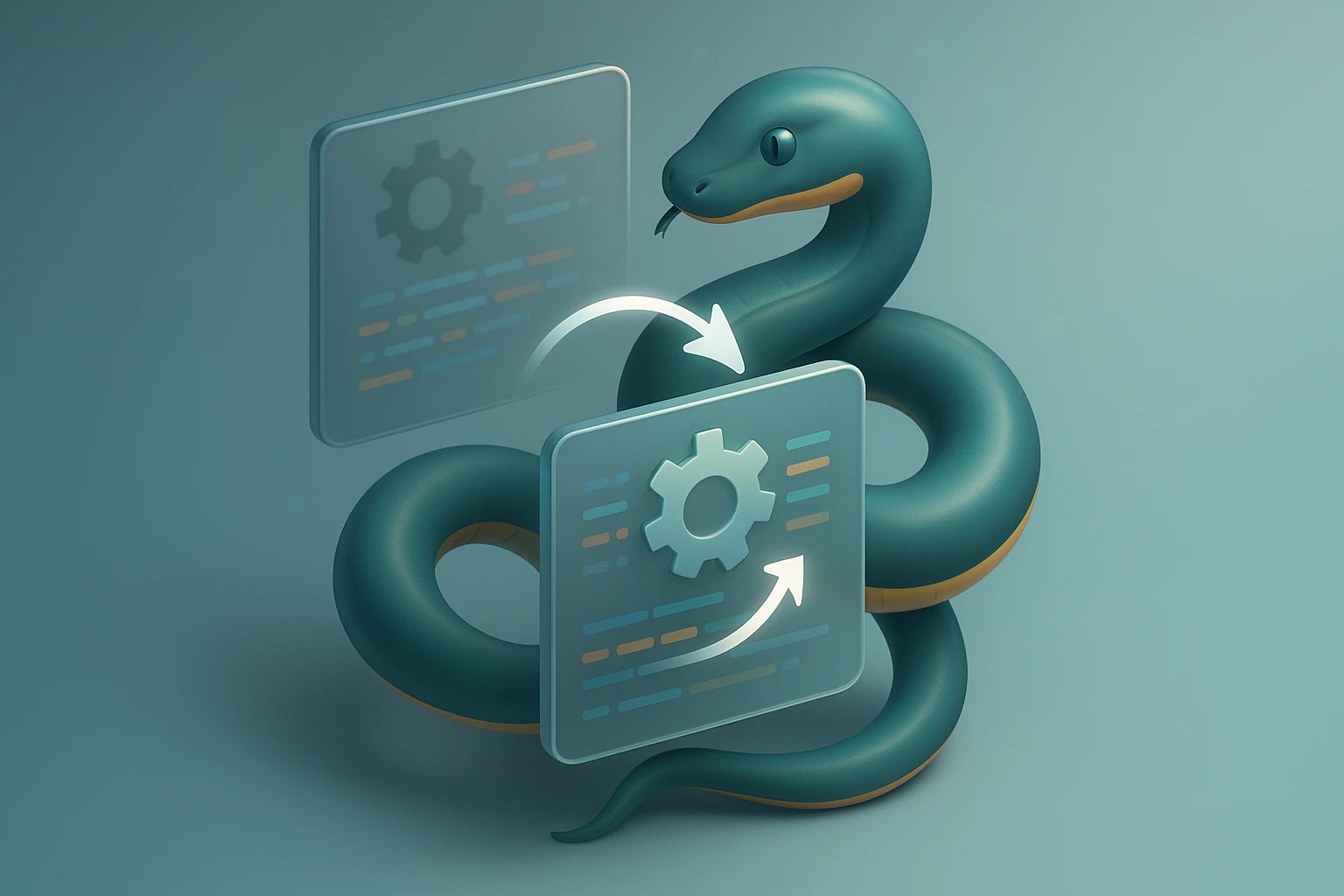What Is Inheritance in Python?
Python inheritance diagram: base class with shared attributes/methods; derived subclasses inherit and override behavior, showing single, multiple, multilevel inheritance relations.

Understanding how to efficiently organize and reuse code is fundamental to becoming a proficient programmer. In Python, inheritance stands as one of the most powerful mechanisms for creating flexible, maintainable, and scalable applications. Whether you're building a small utility script or architecting a complex enterprise system, grasping inheritance will dramatically improve your code quality and development speed.
Inheritance is an object-oriented programming concept that allows a new class to adopt properties and behaviors from an existing class. This parent-child relationship between classes creates a hierarchy where the child class automatically receives all attributes and methods from the parent, while still maintaining the ability to add its own unique features or modify inherited ones. This fundamental principle enables developers to build upon existing code rather than constantly reinventing the wheel.
Throughout this comprehensive exploration, you'll discover the mechanics of Python inheritance, from basic single inheritance to complex multiple inheritance scenarios. We'll examine practical implementation patterns, explore method resolution order, understand when and how to use super(), and identify common pitfalls that can derail your object-oriented designs. By the end, you'll possess the knowledge to leverage inheritance effectively in your Python projects.
The Foundation of Class Inheritance
At its core, inheritance establishes a relationship between two or more classes where one class serves as the blueprint for another. The parent class, often called the base class or superclass, contains common attributes and methods that multiple related classes might need. The child class, known as the derived class or subclass, inherits these features while adding or modifying functionality specific to its purpose.
Python implements inheritance through a straightforward syntax where you specify the parent class in parentheses when defining the child class. This simple mechanism unlocks tremendous power for code organization and reusability. When a child class inherits from a parent, it gains immediate access to all public and protected members of that parent class without needing to redefine them.
"Inheritance isn't just about reusing code—it's about creating meaningful relationships between concepts in your program that mirror real-world hierarchies."
Basic Inheritance Syntax and Structure
Creating an inheritance relationship in Python requires minimal syntax but offers maximum flexibility. The basic structure involves defining a parent class with its attributes and methods, then creating a child class that references the parent in its definition. The child automatically inherits everything from the parent and can immediately use those inherited features.
class Animal:
def __init__(self, name, age):
self.name = name
self.age = age
def make_sound(self):
return "Some generic sound"
def get_info(self):
return f"{self.name} is {self.age} years old"
class Dog(Animal):
def __init__(self, name, age, breed):
super().__init__(name, age)
self.breed = breed
def make_sound(self):
return "Woof! Woof!"
def fetch(self):
return f"{self.name} is fetching the ball"In this example, the Dog class inherits from Animal, gaining access to the name and age attributes along with the get_info method. The Dog class then extends this functionality by adding a breed attribute and a fetch method specific to dogs. It also overrides the make_sound method to provide dog-specific behavior while maintaining the same interface.
Understanding the super() Function
The super() function serves as a bridge between child and parent classes, enabling the child to call methods from its parent without explicitly naming the parent class. This approach promotes flexibility because if you later change the parent class, you won't need to update references throughout the child class. The super() function is particularly crucial in the __init__ method where you typically want to initialize the parent class before adding child-specific attributes.
Using super() becomes even more valuable in multiple inheritance scenarios where it ensures proper method resolution order. Without super(), you might accidentally skip classes in the inheritance chain or call the same parent method multiple times. The function intelligently navigates the class hierarchy to ensure each parent class is called exactly once in the correct order.
| Approach | Syntax Example | Advantages | Use Cases |
|---|---|---|---|
| Using super() | super().__init__(name) | Flexible, maintains MRO, easier refactoring | Modern Python code, multiple inheritance |
| Direct parent call | ParentClass.__init__(self, name) | Explicit, clear which parent is called | Simple single inheritance, debugging |
| No parent call | Only child attributes | Complete independence from parent initialization | When parent __init__ is not needed |
Types of Inheritance Patterns
Python supports several inheritance patterns, each serving different architectural needs. Single inheritance creates a straightforward parent-child relationship, while multiple inheritance allows a class to inherit from several parents simultaneously. Understanding these patterns helps you choose the right approach for your specific design requirements.
Single Inheritance Implementation
Single inheritance represents the simplest and most common inheritance pattern where a child class inherits from exactly one parent class. This linear relationship creates a clear hierarchy that's easy to understand and maintain. Single inheritance works exceptionally well when modeling real-world hierarchies like taxonomies, organizational structures, or type classifications.
class Vehicle:
def __init__(self, brand, model, year):
self.brand = brand
self.model = model
self.year = year
self.is_running = False
def start_engine(self):
self.is_running = True
return f"{self.brand} {self.model} engine started"
def stop_engine(self):
self.is_running = False
return f"{self.brand} {self.model} engine stopped"
class ElectricVehicle(Vehicle):
def __init__(self, brand, model, year, battery_capacity):
super().__init__(brand, model, year)
self.battery_capacity = battery_capacity
self.charge_level = 100
def charge(self, amount):
self.charge_level = min(100, self.charge_level + amount)
return f"Charged to {self.charge_level}%"
def get_range(self):
return self.battery_capacity * self.charge_level / 100Multiple Inheritance and Its Complexity
Multiple inheritance allows a class to inherit from multiple parent classes simultaneously, combining features from different sources. While powerful, this pattern introduces complexity through the method resolution order (MRO), which determines which parent class method gets called when multiple parents define the same method. Python uses the C3 linearization algorithm to establish a consistent and predictable MRO.
"Multiple inheritance is like having multiple mentors—each brings valuable knowledge, but you need a clear system to decide whose advice to follow when they disagree."
class Flyable:
def __init__(self):
self.altitude = 0
def take_off(self):
self.altitude = 1000
return "Taking off into the sky"
def land(self):
self.altitude = 0
return "Landing safely"
class Swimmable:
def __init__(self):
self.depth = 0
def dive(self):
self.depth = 50
return "Diving underwater"
def surface(self):
self.depth = 0
return "Surfacing"
class Duck(Flyable, Swimmable):
def __init__(self, name):
Flyable.__init__(self)
Swimmable.__init__(self)
self.name = name
def quack(self):
return f"{self.name} says quack!"Multilevel Inheritance Chains
Multilevel inheritance creates a chain where a class inherits from a parent, which itself inherits from another parent, forming a grandparent-parent-child relationship. This pattern naturally models hierarchies with multiple levels of abstraction, such as biological classifications or organizational hierarchies. Each level in the chain adds more specific attributes and behaviors while maintaining access to all ancestor features.
The key advantage of multilevel inheritance lies in its ability to create increasingly specialized classes while maintaining a clear lineage. Each level can add new functionality or override inherited methods to provide more specific implementations. This approach promotes code reuse across multiple levels while allowing each level to focus on its specific concerns.
Method Overriding and Extension
One of the most powerful aspects of inheritance is the ability to modify inherited behavior through method overriding. When a child class defines a method with the same name as a parent class method, the child's version takes precedence. This mechanism allows you to customize behavior for specific subclasses while maintaining a consistent interface across the inheritance hierarchy.
Complete Method Override
Complete method override replaces the parent's method entirely with a new implementation in the child class. This approach works well when the child class needs fundamentally different behavior that doesn't build upon the parent's implementation. The child method has the same signature as the parent but provides completely independent functionality.
class PaymentProcessor:
def process_payment(self, amount):
return f"Processing ${amount} payment"
def validate_payment(self, amount):
return amount > 0
class CreditCardProcessor(PaymentProcessor):
def process_payment(self, amount):
if not self.validate_payment(amount):
return "Invalid payment amount"
return f"Processing ${amount} via credit card with 3% fee"
class CryptoCurrencyProcessor(PaymentProcessor):
def process_payment(self, amount):
if not self.validate_payment(amount):
return "Invalid payment amount"
return f"Processing ${amount} via cryptocurrency with blockchain verification"Extending Parent Methods
Rather than completely replacing parent functionality, you often want to extend it by adding additional behavior before or after calling the parent's method. This pattern uses super() to invoke the parent method while wrapping it with child-specific logic. This approach maintains the parent's behavior while augmenting it with new features.
"The beauty of method extension lies in building upon existing functionality rather than recreating it—standing on the shoulders of giants, as it were."
class Logger:
def log(self, message):
print(f"LOG: {message}")
class TimestampedLogger(Logger):
def log(self, message):
from datetime import datetime
timestamp = datetime.now().strftime("%Y-%m-%d %H:%M:%S")
super().log(f"[{timestamp}] {message}")
class FileLogger(TimestampedLogger):
def __init__(self, filename):
self.filename = filename
def log(self, message):
super().log(message)
with open(self.filename, 'a') as f:
f.write(message + '\n')Access Control and Encapsulation
Python provides naming conventions to control attribute and method visibility within inheritance hierarchies. While Python doesn't enforce strict access control like some languages, it uses naming conventions to signal intended visibility. Understanding these conventions helps you design clearer interfaces and protect internal implementation details from external access.
Public, Protected, and Private Members
Public members have no prefix and are freely accessible from anywhere. Protected members use a single underscore prefix (_attribute) to signal they're intended for internal use within the class and its subclasses, though Python doesn't prevent external access. Private members use a double underscore prefix (__attribute) and undergo name mangling to make them harder to access from outside the class.
- 🔓 Public members form the official interface of your class and should remain stable across versions
- 🔒 Protected members indicate internal implementation details that subclasses can use but external code should avoid
- 🔐 Private members are strictly internal to the class and undergo name mangling to prevent accidental access
- 📋 Naming conventions serve as documentation of intent even though Python doesn't enforce them strictly
- ⚠️ Name mangling transforms __attribute to _ClassName__attribute to avoid naming conflicts in inheritance
class BankAccount:
def __init__(self, account_number, balance):
self.account_number = account_number # Public
self._balance = balance # Protected
self.__pin = "1234" # Private
def get_balance(self):
return self._balance
def __verify_pin(self, pin):
return pin == self.__pin
def withdraw(self, amount, pin):
if self.__verify_pin(pin):
if amount <= self._balance:
self._balance -= amount
return True
return False
class SavingsAccount(BankAccount):
def __init__(self, account_number, balance, interest_rate):
super().__init__(account_number, balance)
self.interest_rate = interest_rate
def add_interest(self):
# Can access protected _balance
interest = self._balance * self.interest_rate
self._balance += interest
return interestAbstract Base Classes and Interfaces
Abstract base classes (ABCs) define interfaces that child classes must implement, ensuring consistency across related classes. Python's abc module provides tools for creating abstract classes that cannot be instantiated directly and abstract methods that child classes must override. This pattern enforces contracts between parent and child classes, making your inheritance hierarchies more robust and predictable.
Creating Abstract Classes
Abstract classes serve as templates that define what methods a child class must implement without providing the implementation themselves. By inheriting from ABC and decorating methods with @abstractmethod, you create a contract that child classes must fulfill. Attempting to instantiate an abstract class or a child class that hasn't implemented all abstract methods results in a TypeError.
from abc import ABC, abstractmethod
class Shape(ABC):
@abstractmethod
def area(self):
pass
@abstractmethod
def perimeter(self):
pass
def describe(self):
return f"This shape has area {self.area()} and perimeter {self.perimeter()}"
class Rectangle(Shape):
def __init__(self, width, height):
self.width = width
self.height = height
def area(self):
return self.width * self.height
def perimeter(self):
return 2 * (self.width + self.height)
class Circle(Shape):
def __init__(self, radius):
self.radius = radius
def area(self):
return 3.14159 * self.radius ** 2
def perimeter(self):
return 2 * 3.14159 * self.radius"Abstract base classes transform inheritance from a mechanism of code reuse into a system of guaranteed contracts and consistent interfaces."
Interface Segregation with ABCs
Rather than creating monolithic abstract classes with many methods, you can create multiple focused abstract classes that each define a specific capability. Child classes can then inherit from multiple ABCs to indicate they support multiple interfaces. This approach follows the interface segregation principle, keeping interfaces small and focused.
| Pattern | Description | Benefits | Example Use Case |
|---|---|---|---|
| Single ABC | One abstract class with all required methods | Simple, clear hierarchy | Basic shapes with area and perimeter |
| Multiple ABCs | Several focused abstract classes | Flexible composition, interface segregation | Serializable, Comparable, Drawable interfaces |
| Mixin ABCs | Abstract classes providing partial implementations | Code reuse with enforced contracts | Timestamped, Loggable, Cacheable behaviors |
| Protocol Classes | Structural subtyping without inheritance | Duck typing with type checking | File-like objects, iterator protocols |
Composition vs Inheritance
While inheritance is powerful, it's not always the best solution for code reuse. Composition, where a class contains instances of other classes rather than inheriting from them, often provides more flexibility and clearer relationships. Understanding when to use inheritance versus composition is crucial for creating maintainable object-oriented designs.
When to Choose Inheritance
Inheritance works best when you have a genuine "is-a" relationship between classes. If you can naturally say that one class is a type of another class, inheritance makes sense. For example, a Dog is an Animal, a SavingsAccount is a BankAccount, and a Manager is an Employee. These relationships benefit from inheritance because the child class truly represents a specialized version of the parent class.
Inheritance also shines when you need polymorphism—the ability to treat different classes uniformly through a common interface. When multiple classes share the same parent and override its methods, you can write code that works with the parent type but automatically uses the appropriate child implementation at runtime. This flexibility is difficult to achieve with composition alone.
When to Choose Composition
Composition proves superior when you have a "has-a" relationship rather than an "is-a" relationship. A Car has an Engine, a Computer has a Processor, and a House has Rooms. These relationships don't benefit from inheritance because the contained object isn't a specialized version of the container. Composition also provides more flexibility because you can easily swap out components at runtime.
"Favor composition over inheritance not because inheritance is bad, but because composition often provides the flexibility you need without the tight coupling inheritance creates."
# Inheritance approach (tight coupling)
class Bird:
def fly(self):
return "Flying through the air"
class Penguin(Bird):
def fly(self):
raise NotImplementedError("Penguins can't fly!")
# Composition approach (flexible)
class FlyingAbility:
def fly(self):
return "Flying through the air"
class SwimmingAbility:
def swim(self):
return "Swimming through water"
class Sparrow:
def __init__(self):
self.flying = FlyingAbility()
def move(self):
return self.flying.fly()
class Penguin:
def __init__(self):
self.swimming = SwimmingAbility()
def move(self):
return self.swimming.swim()Common Pitfalls and Best Practices
Inheritance introduces complexity that can lead to maintenance nightmares if not used carefully. Deep inheritance hierarchies become difficult to understand and modify. Diamond inheritance patterns in multiple inheritance can cause ambiguity about which parent method should be called. Fragile base class problems occur when changes to a parent class unexpectedly break child classes.
Avoiding Deep Inheritance Hierarchies
Deep inheritance hierarchies, where classes inherit from classes that inherit from classes through many levels, create code that's difficult to understand and maintain. Each level adds cognitive load because you must understand the entire chain to comprehend any single class. Changes at high levels ripple through the entire hierarchy, potentially breaking distant descendants in unexpected ways.
As a general guideline, try to keep inheritance hierarchies to three or four levels maximum. If you find yourself creating deeper hierarchies, consider whether composition or multiple inheritance with mixins might better express your design. Sometimes a deep hierarchy indicates you're trying to model too many concepts through inheritance when other patterns would be clearer.
The Liskov Substitution Principle
The Liskov Substitution Principle states that objects of a child class should be substitutable for objects of the parent class without breaking the program. This means child classes should strengthen, not weaken, the contracts established by their parents. A child class shouldn't remove functionality, throw exceptions where the parent doesn't, or change the meaning of inherited methods in ways that violate caller expectations.
"Inheritance creates a promise between parent and child—the child commits to being a proper, well-behaved version of the parent, not a rebellious impostor."
# Violates Liskov Substitution Principle
class Rectangle:
def __init__(self, width, height):
self.width = width
self.height = height
def set_width(self, width):
self.width = width
def set_height(self, height):
self.height = height
def area(self):
return self.width * self.height
class Square(Rectangle):
def set_width(self, width):
self.width = width
self.height = width # Changes both dimensions
def set_height(self, height):
self.width = height # Changes both dimensions
self.height = height
# This breaks expectations:
def test_rectangle(rect):
rect.set_width(5)
rect.set_height(4)
assert rect.area() == 20 # Fails for Square!Managing Method Resolution Order
In multiple inheritance, Python uses the C3 linearization algorithm to determine method resolution order (MRO). This algorithm ensures each class appears before its parents and maintains the order specified in the class definition. Understanding MRO helps you predict which method will be called when multiple parents define the same method and debug unexpected behavior in complex inheritance hierarchies.
You can inspect a class's MRO using the __mro__ attribute or the mro() method. This shows the exact order Python will search for methods, which is especially valuable when debugging multiple inheritance issues. When designing multiple inheritance hierarchies, arrange parent classes thoughtfully and use super() consistently to ensure proper method chaining through the MRO.
Practical Applications and Design Patterns
Inheritance enables several powerful design patterns that solve common software architecture problems. The Template Method pattern uses inheritance to define the skeleton of an algorithm while letting subclasses override specific steps. The Factory Method pattern uses inheritance to delegate object creation to subclasses. Understanding these patterns helps you recognize situations where inheritance provides elegant solutions.
Template Method Pattern
The Template Method pattern defines the overall structure of an algorithm in a parent class while allowing child classes to override specific steps. The parent class contains a template method that calls several hook methods, which child classes can override to customize behavior. This pattern promotes code reuse by centralizing the algorithm structure while providing customization points.
class DataProcessor(ABC):
def process(self, data):
raw_data = self.load_data(data)
validated_data = self.validate_data(raw_data)
transformed_data = self.transform_data(validated_data)
self.save_data(transformed_data)
return transformed_data
@abstractmethod
def load_data(self, source):
pass
@abstractmethod
def validate_data(self, data):
pass
@abstractmethod
def transform_data(self, data):
pass
@abstractmethod
def save_data(self, data):
pass
class CSVProcessor(DataProcessor):
def load_data(self, source):
# Load from CSV file
return []
def validate_data(self, data):
# CSV-specific validation
return data
def transform_data(self, data):
# CSV-specific transformation
return data
def save_data(self, data):
# Save as CSV
pass
class JSONProcessor(DataProcessor):
def load_data(self, source):
# Load from JSON file
return {}
def validate_data(self, data):
# JSON-specific validation
return data
def transform_data(self, data):
# JSON-specific transformation
return data
def save_data(self, data):
# Save as JSON
passMixin Classes for Reusable Functionality
Mixins are small classes designed to provide specific functionality that can be mixed into other classes through multiple inheritance. Unlike traditional inheritance where the child "is-a" parent, mixins provide "has-a-capability" relationships. Mixins typically don't stand alone but add specific behaviors to classes that inherit from them alongside other parent classes.
Well-designed mixins focus on a single responsibility and don't depend on attributes or methods from other classes. They provide self-contained functionality that any class can adopt. This approach allows you to compose complex behaviors from simple, reusable components without creating deep inheritance hierarchies.
class TimestampMixin:
def add_timestamp(self):
from datetime import datetime
self.created_at = datetime.now()
return self.created_at
class SerializableMixin:
def to_dict(self):
return {k: v for k, v in self.__dict__.items()
if not k.startswith('_')}
def to_json(self):
import json
return json.dumps(self.to_dict())
class ValidatableMixin:
def validate(self):
errors = []
for field, value in self.__dict__.items():
if value is None:
errors.append(f"{field} cannot be None")
return errors
class User(TimestampMixin, SerializableMixin, ValidatableMixin):
def __init__(self, username, email):
self.username = username
self.email = email
self.add_timestamp()Performance Considerations
Inheritance introduces minimal performance overhead in Python, but understanding the implications helps you make informed design decisions. Method lookups in inheritance hierarchies require Python to search through the MRO, which takes slightly longer than calling a method directly defined in a class. However, this overhead is usually negligible compared to the actual work methods perform.
The real performance impact of inheritance comes from design choices rather than the mechanism itself. Deep inheritance hierarchies increase lookup time proportionally to depth. Multiple inheritance with complex MRO patterns adds additional overhead. However, these costs rarely matter in practice unless you're calling inherited methods in extremely tight loops where every microsecond counts.
More significant than raw performance is the maintainability and flexibility inheritance provides. Code that's easier to understand, modify, and extend typically delivers better long-term performance through cleaner architecture and fewer bugs. The slight overhead of inheritance is a small price to pay for well-organized, reusable code that's easier to optimize when performance actually becomes a concern.
How does Python handle multiple inheritance conflicts?
Python uses the C3 linearization algorithm to create a Method Resolution Order (MRO) that determines which parent class method gets called when multiple parents define the same method. You can view the MRO using ClassName.__mro__ or ClassName.mro(). The algorithm ensures each class appears before its parents and maintains the order specified in the class definition. Using super() consistently ensures proper method chaining through the MRO.
Can I prevent a class from being inherited?
Python doesn't provide a built-in mechanism like Java's final keyword to prevent inheritance. However, you can implement this behavior by overriding __init_subclass__ in your class to raise an exception when someone tries to inherit from it. This approach isn't commonly used in Python because the language philosophy favors trust and flexibility over strict enforcement.
What's the difference between isinstance() and type() with inheritance?
The isinstance() function returns True if an object is an instance of a class or any of its parent classes, making it inheritance-aware. The type() function returns the exact class of an object without considering inheritance. For example, isinstance(dog, Animal) returns True if Dog inherits from Animal, while type(dog) == Animal returns False. Always prefer isinstance() for type checking in inheritance hierarchies.
Should I use inheritance for code reuse?
Inheritance should primarily model "is-a" relationships rather than serve as a code reuse mechanism. If you only want to reuse code without a genuine hierarchical relationship, consider composition, mixins, or utility functions instead. Inheritance creates tight coupling between parent and child classes, so use it when the relationship genuinely represents specialization or categorization.
How do I access a grandparent class method directly?
You can call a specific ancestor's method by explicitly referencing it: GrandparentClass.method_name(self, args). However, this approach bypasses the MRO and can cause maintenance problems if the inheritance hierarchy changes. It's better to design your hierarchy so each class properly calls super() to maintain proper method chaining through all ancestors.
What happens to class attributes in inheritance?
Class attributes are inherited by child classes and shared across all instances of both parent and child classes unless explicitly overridden. If a child class assigns a new value to a class attribute, it creates a new attribute specific to that child class, leaving the parent's attribute unchanged. Instance attributes, defined in __init__, are not inherited but can be initialized through super().__init__() calls.




